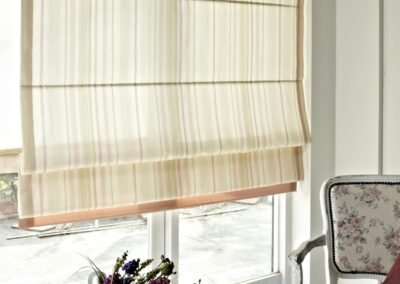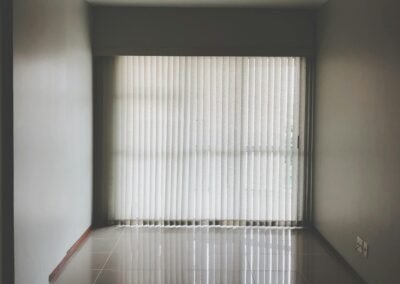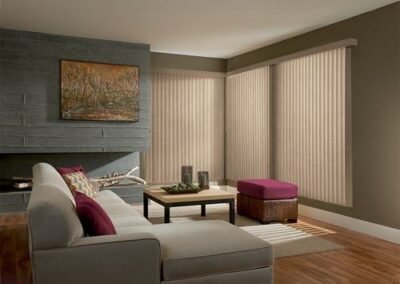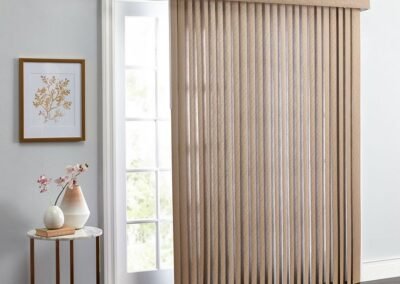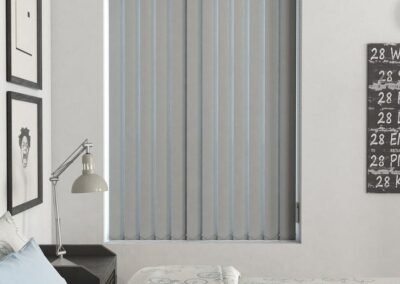Vertical blinds have become a popular choice for window coverings, valued for their sleek and contemporary design, as well as their practicality in managing both light and privacy in various spaces. Composed of individual slats that hang vertically, these blinds offer users the flexibility to easily rotate the slats or draw them to one side, allowing precise control over the amount of natural light entering a room and the level of visibility from the outside.
First gaining traction in the 1960s, vertical blinds have since evolved significantly in terms of materials, colors, and patterns. Early versions were often made from vinyl, but today, they can be found in a variety of materials, including durable fabrics, wood, and aluminum, each providing unique aesthetic and functional benefits. This evolution has made vertical blinds a versatile and modern choice for homeowners seeking to enhance their interior décor while maintaining practicality.
Moreover, their ability to be customized in terms of size and style means they can fit a wide range of window types, including large sliding glass doors and expansive picture windows. As a result, vertical blinds remain a highly sought-after option for those looking to combine functionality with contemporary style in their homes.
Blinds in Qatar
Blinds are more than just window coverings; they play a crucial role in enhancing the aesthetic appeal and functionality of any space. In Qatar, where the climate can be harsh, blinds offer a practical solution for controlling light, ensuring privacy, and maintaining indoor temperatures
Types of Blinds
Roller Blinds
Roller blinds are a popular choice due to their simplicity and versatility. They consist of a single piece of fabric that rolls up and down, making them easy to operate and ideal for minimalist decor.
Venetian Blinds
Venetian blinds feature horizontal slats that can be tilted to control the amount of light entering a room. They are available in various materials, including wood, aluminum, and PVC, catering to different tastes and budgets.
Vertical Blinds
blinds are perfect for large windows and sliding doors. Their vertical slats can be rotated to control light and privacy, making them a practical and stylish option for modern homes.
Roman Blinds
Roman blinds are made from fabric that folds neatly into pleats when raised. They offer a soft, elegant look and are available in various patterns and colors to complement any decor.
Panel Blinds
Panel blinds are ideal for larger windows or as room dividers. They consist of wide fabric panels that slide across a track, offering a contemporary look and excellent light control.
Smart Blinds
Smart blinds integrate with home automation systems, allowing you to control them via a smartphone or voice assistant. They offer convenience and can be programmed to open and close at specific times, enhancing energy efficiency.
Design and Style Options
Color Choices
blinds come in a wide range of colors, from neutral tones like white, beige, and gray to bold, vibrant hues like red, blue, and green. This variety allows you to match the blinds with your existing decor or make a statement with a contrasting color.
Patterns and Textures
In addition to solid colors, vertical blinds are available in various patterns and textures, such as geometric designs, floral prints, and embossed finishes. These options add visual interest and depth to your window treatments.
Customization Options
Many manufacturers offer customization options, allowing you to choose the exact size, material, and design features that suit your needs. Custom vertical blinds can be tailored to fit unusual window shapes and sizes, providing a perfect fit every time.
Measuring and Installation
How to Measure for Vertical Blinds
Accurate measurements are crucial for a perfect fit. Measure the width and height of the window frame, ensuring to account for any obstructions like handles or trim. It’s often recommended to take measurements at multiple points and use the smallest dimensions to ensure the blinds fit within the frame.
Installation Process
Installing vertical blinds is a straightforward process that involves attaching the headrail to the top of the window frame and hanging the slats from the headrail. Most kits come with all the necessary hardware and instructions.
Professional Installation vs. DIY
While many homeowners opt to install vertical blinds themselves, professional installation can save time and ensure a flawless finish, especially for larger or more complex installations.
Maintenance and Cleaning
Cleaning Tips for Fabric Blinds
Fabric vertical blinds should be vacuumed regularly using an upholstery attachment to remove dust and debris. For deeper cleaning, they can be spot-cleaned with a mild detergent and warm water.
Cleaning Tips for Vinyl Blinds
Vinyl blinds can be wiped down with a damp cloth or sponge. For tougher stains, a mixture of water and mild dish soap can be used. Avoid using abrasive cleaners, which can damage the surface.
Preventing Damage
To prevent damage to your vertical blinds, handle them gently when opening and closing, and avoid exposing them to excessive moisture or direct sunlight for prolonged periods.
Vertical Blinds vs. Other Window Treatments
Blinds vs. Horizontal Blinds
blinds are ideal for large windows and sliding glass doors, while horizontal blinds are better suited for smaller windows. Vertical blinds also tend to be easier to clean and maintain.
Blinds vs. Curtains
While curtains offer a softer, more traditional look, vertical blinds provide a more modern, streamlined appearance. Blinds also offer better light control and are generally easier to clean.
Blinds vs. Roller Shades
Roller shades provide a minimalist look and can be completely rolled up to allow maximum light, but vertical blinds offer more flexibility in terms of light control and privacy.
Contact us Today & Get a Free Consulation at your Door-Step.

